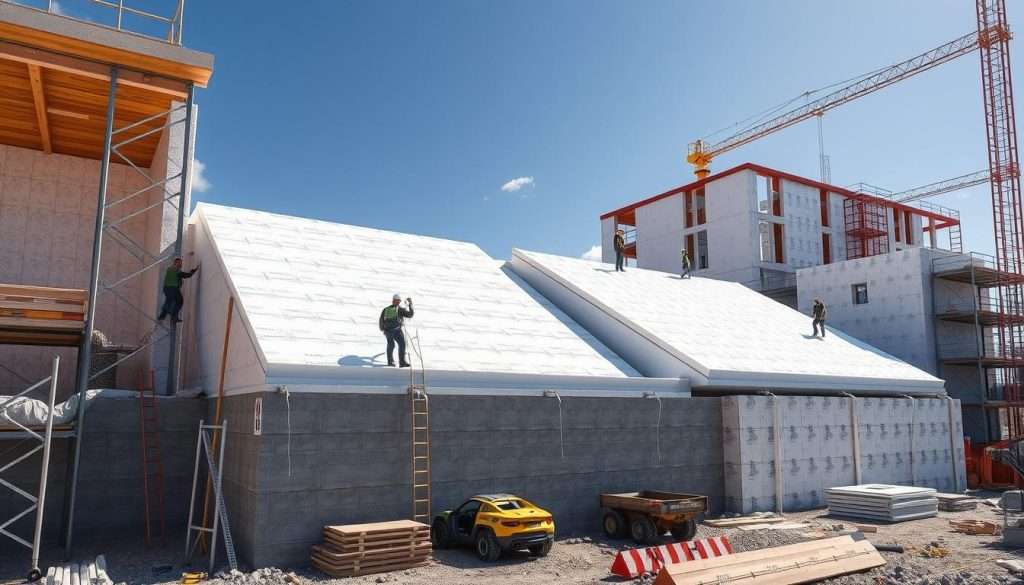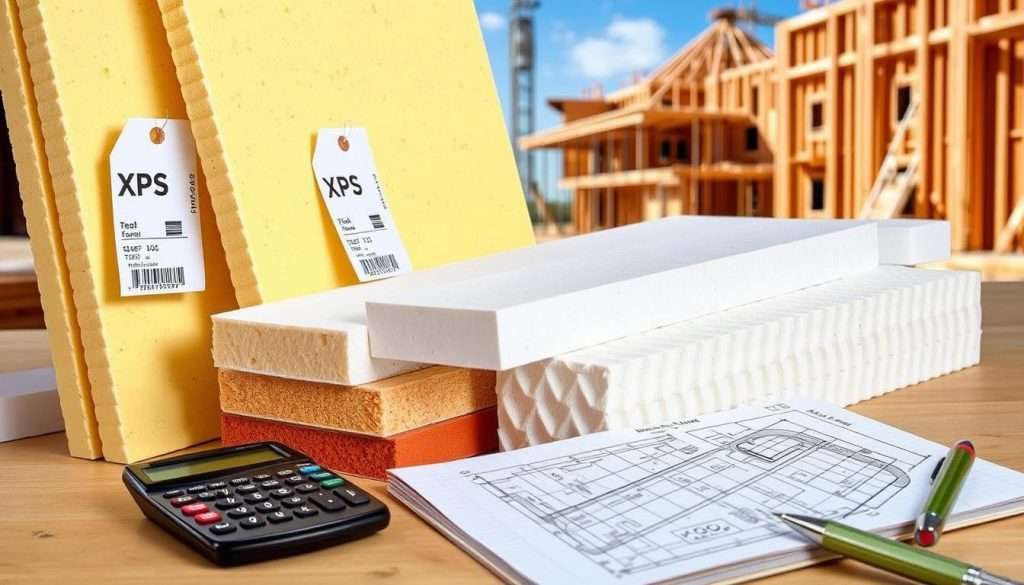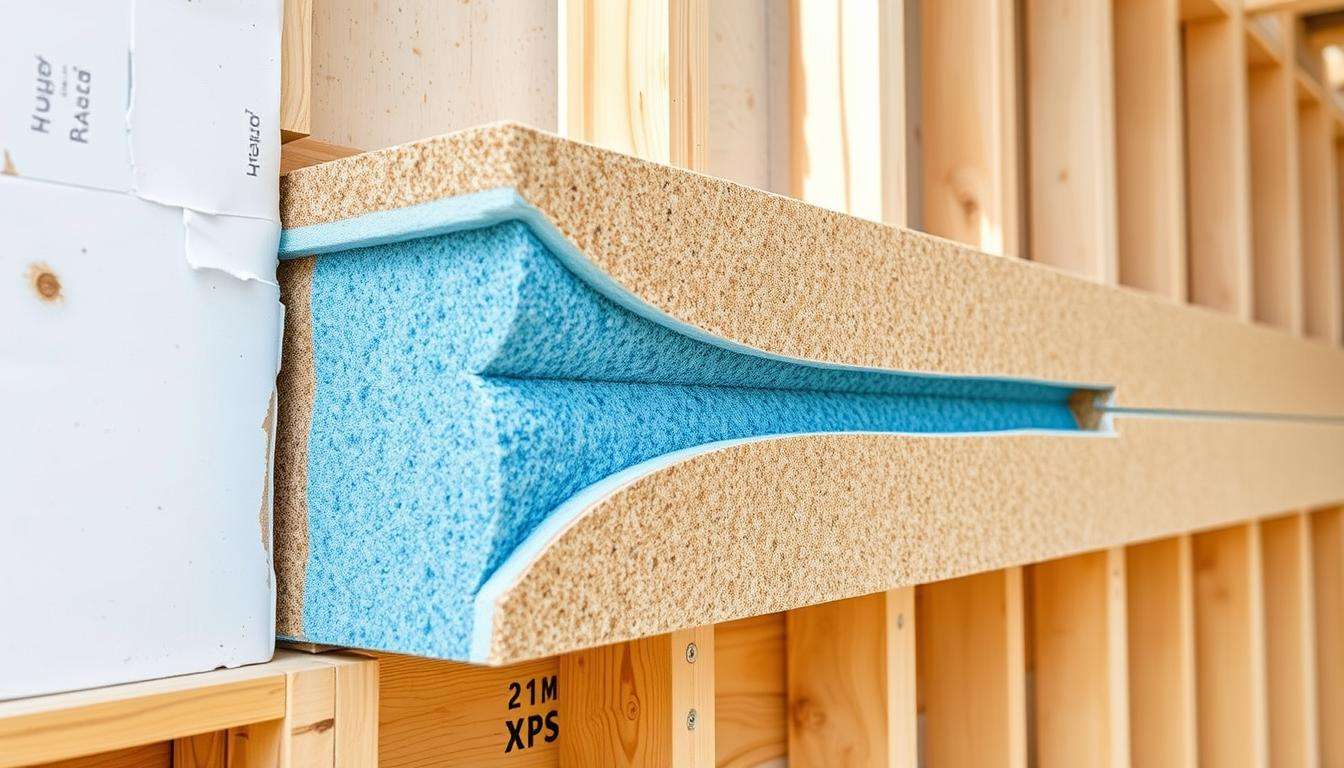In today’s world, knowing about insulation is key for everyone. XPS insulation, or extruded polystyrene, is a standout. It’s a rigid foam that keeps your home comfy all year. You can find it in sizes like 24” x 96” or 48” x 96”, and it’s up to 4” thick.
XPS has a high R-value of R5 per inch. This means it saves energy and makes buildings more efficient. It’s tough and works well in tough places, especially when it’s cold.
It also resists moisture well, making it great for places like foundation walls and roofs. In this article, we’ll dive into XPS insulation’s benefits and uses. This will help you make your home more energy-efficient.
Key Takeaways
- XPS insulation is a rigid foam material ideal for energy-efficient construction.
- It comes in standard sizes and thicknesses, providing versatile installation options.
- The material features a high R-value, ensuring excellent thermal performance.
- Moisture resistance makes XPS suitable for various applications, including foundations.
- XPS is 100% recyclable, contributing to sustainable building practices.
What is XPS Insulation?
XPS insulation is a top pick for homes wanting to save energy and keep moisture out. It’s made from a special process that makes it strong and keeps air out. This makes it great for keeping your home warm and dry.
Definition and Overview
XPS insulation is key for homes that need to save energy and stay dry. It has a high R-value, which means it helps keep your home warm. It’s also very light but strong, making it perfect for many building needs.
Properties and Characteristics
- High Moisture Resistance: XPS insulation is very good at keeping moisture out. It can handle being underwater without getting too wet. This makes it great for places like foundation walls.
- Superior Compressive Strength: This insulation is strong enough to handle heavy loads. It’s perfect for areas that need extra support.
- Durability: It keeps its R-value over time, even when the weather changes. This means it keeps your home warm for years to come.
- Resistance to Mold and Mildew: Both XPS and EPS insulation stop mold and mildew from growing. This helps keep your home healthy and clean.
Historical Context of XPS Insulation
XPS insulation has come a long way. It started as closed-cell polystyrene foam. Now, it’s a key part of building construction.
Its journey shows growth in energy saving, lasting longer, and being better for the planet. Knowing its history helps us see its value today.
Development and Evolution
XPS insulation first appeared in the 1950s as Styrofoam. The Dow Chemical Company created it in 1941 for the navy. It became a building material because of its great heat control.
Important steps include:
- Starting to make it without freon from 1995 to 2001, helping the environment.
- Adding new fire stoppers in August 2015, making buildings safer.
- Creating thicker, better insulating foam boards, keeping buildings warm or cool.
Key Milestones in Insulation Technology
XPS insulation has hit many important marks. These have made it a key part of building energy efficiency. Key moments include:
- Lowering carbon emissions by 94% in Styrofoam™ Brand XPS.
- Starting to use 20% recycled content, meeting green goals.
- Keeping buildings warm or cool, even when wet, for a long time.
- Going to Europe in the 1960s, leading to more factories from 1964 to 2000.
Benefits of Using XPS Insulation
XPS insulation is great for many reasons. It makes homes more energy-efficient. Knowing its benefits helps homeowners make smart choices.
Energy Efficiency
XPS insulation keeps your home’s temperature steady. It has an R-value of 4.6 to 5.0. This means you use less energy for heating and cooling.
Using XPS can save up to 40 BTUs for every BTU used. Adding more layers reduces heat loss. This makes your home more energy-efficient.
Moisture Resistance
XPS insulation absorbs very little moisture, just 0.3%. It’s perfect for places with lots of moisture, like basements. It keeps water out, protecting your home.
Durability and Longevity
XPS insulation lasts over 100 years if installed right. It works well in many places. Its strength is over 300 kPa, making it great for heavy loads.
Common Applications of XPS Insulation
XPS insulation is used in many places. It’s good for buildings in homes, offices, and factories. It helps save energy and keeps buildings strong.
Residential Construction
In homes, XPS is used in walls, roofs, and floors. It has a high R-value, which means it keeps homes warm in winter and cool in summer. This helps lower the cost of heating and cooling.
Commercial Buildings
Commercial buildings use XPS for keeping warm and dry. It’s great in cold places like storage rooms. XPS also keeps moisture out, which is good for buildings.
Industrial Uses
Industrial places use XPS for floors and foundations. It’s strong and can handle heavy things. It’s perfect for places that need to stay at a certain temperature, like farms or airports.

Comparing XPS Insulation to Other Types
Choosing the right insulation is key. We need to know the differences between XPS, EPS, and Polyiso. Each has its own benefits and costs. Let’s look at how XPS compares to EPS and Polyiso, focusing on R-value, moisture resistance, and where to use them.
XPS vs. EPS
EPS is cheaper, costing about 25 to 30 cents per square foot for a 1-inch panel. But, it has an R-value of 4 to 4.5 per inch. XPS is stronger and absorbs less water, making it better for underground use.
XPS vs. Polyiso
Polyiso has a higher R-value, from 5.6 to 7.0 per inch. It’s often used for roofs. XPS is better at fighting moisture, which is important for long-term use.
Performance Metrics
Here’s how XPS, EPS, and Polyiso compare:
| Material | R-Value per Inch | Cost per sq. ft. (1 in. thick) | Moisture Resistance | Compressive Strength |
|---|---|---|---|---|
| EPS | 4.0 – 4.5 | $0.25 – $0.30 | Lower | Variable, requires higher density for comparable strength |
| XPS | 5.0 – 6.0 | $0.42 | Medium | Higher |
| Polyiso | 5.6 – 7.0 | $0.70 | Medium to High | Higher |
XPS insulation is reliable for keeping things warm and strong. It’s not the cheapest, but it’s good at fighting moisture. This makes it a great choice for certain jobs.
Installation Process of XPS Insulation
Knowing how to install XPS insulation is key for the best results. It makes sure insulation works well to save energy and last longer. Before starting, get ready with some important steps.
Preparation and Considerations
First, check the area where you’ll install the insulation. It should be clean and dry for the insulation to stick well. Here’s what you need to do:
- Look for any damage or moisture in the area.
- Put on safety gear like gloves, goggles, and a dust mask.
- Measure the space carefully.
- Cut the insulation panels to fit perfectly.
Step-by-Step Installation Guide
Here’s a simple guide to install XPS insulation right:
- Cut the panels to the right size.
- Use adhesive or fasteners to hold them in place.
- Press the panels hard against the surface.
- Seal the edges with tape or more adhesive for tightness.
By following this guide, you make your insulation work better. This helps your building use less energy.
Environmental Impact of XPS Insulation
The environmental impact of XPS insulation is a big deal. It’s about being green and recycling. When picking insulation, think about how it affects the planet. This part talks about green concerns and recycling XPS.
Sustainability Concerns
XPS insulation is good at keeping things warm and lasting long. But, some XPS has chemicals that harm the ozone layer. These chemicals, like HFC-134a, make the Earth warmer.
Choosing brands that use safer chemicals helps the planet. This choice supports the move towards greener building. It’s good for our planet.
Recycling Options
Most XPS insulation can be recycled. This is key to reducing waste. Recycling helps keep our landfills cleaner.
Knowing where to recycle XPS is important. It helps make building greener. By recycling, we all help the Earth.
Cost Considerations for XPS Insulation
When looking at XPS insulation, knowing the costs is key. The first cost might seem high, but it saves money on bills and boosts your home’s value. We’ll look at what affects prices and how they fit into your budget.
Initial Investment vs. Long-term Savings
XPS insulation costs can change a lot. Prices are between $0.70 to $1.50 per square foot, based on thickness and R-value. Adding installation costs, it’s $1.50 to $3.50 more per square foot. But, XPS saves money on energy, making it worth the start-up cost.
Factors Affecting Pricing
Several things can change how much XPS insulation costs. Think about these when you buy:
- Material Quality: Better insulation costs more. Owens Corning and Kingspan offer different quality levels.
- Thickness: Thicker insulation costs more but saves more energy.
- Brand: Famous brands might charge more for their quality.
- Local Availability: Prices change with local demand and supply. Buying in bulk saves money.
Here’s a table showing some XPS insulation products and their prices:
| Product | Size (4ft x 8ft) | Price (USD) |
|---|---|---|
| Owens Corning FOAMULAR 150 | 4ft x 8ft | Starting from $29.48 |
| Dupont XPS 150 Blue Board | 4ft x 8ft | Starting from $43.67 |
| Kingspan GreenGuard GG25-LG | 4ft x 8ft | $3,106.22 |
| Kingspan GreenGuard GG60-LG | 96 boards | $5,401.96 |
| SOPRA XPS | Varies by application | Competitively priced |

In summary, think about these points when choosing insulation. Knowing the long-term benefits and costs helps make your home more efficient and budget-friendly.
Regulatory Standards for XPS Insulation
Knowing the rules for XPS insulation is key. Building codes get stricter, so following these rules is important. It makes sure insulation works well and is good for the environment.
Both homes and businesses need to follow these rules. This keeps everyone safe and helps the planet.
Building Codes and Compliance
XPS insulation must meet local building codes. These codes say how well insulation should work. Styrofoam™ Brand XPS meets many standards, like ASTM C578 and the International Residential Code (IRC).
Building codes also check if materials are safe. They look at how fast a material burns and how much smoke it makes. This makes sure buildings are safe.
Testing and Certifications
Getting insulation certified is very important. It shows the insulation works well and is safe. For example, Styrofoam™ Brand XPS is made with 100% renewable electricity.
This makes it good for the planet. Certifications like ICC-ESR 4755 show these products meet new standards. This helps buildings stay safe and green.
| Standard | Description | Compliance Date |
|---|---|---|
| ASTM C578 | Standard Specification for Rigid, Cellular Polystyrene Insulation | Ongoing |
| Building Code Compliance | Minimum R-value and fire safety requirements | Varies by state |
| ICC-ESR 4755 | Evaluation report for Styrofoam™ Brand XPS | Ongoing |
| Low-GWP Regulations | Prohibition on high-GWP products starting 2025 | January 1, 2025 |
Maintenance Tips for XPS Insulation
Keeping your XPS insulation in good shape is key. By following some easy maintenance tips, you can make your home more energy-efficient. Regular checks, fixes, and sealing are important for keeping your insulation working well.
Inspection and Repair
Check your XPS insulation every year. Look for:
- Moisture buildup
- Physical damage
- Mold or mildew
If you find problems, fix them fast. Use products like Great Stuff Pro™ Construction Adhesive for repairs. Sealing seams well also helps keep air out.
Enhancing Longevity
To make your insulation last longer, do these things:
- Seal air leaks well
- Clean it regularly
- Fix any damage quickly
Great Stuff Pro™ Gaps & Cracks can help your insulation work better. Spray foam is great for sealing gaps. Also, pick the right fasteners from Hilti or ITW Buildex for your needs.
Future Trends in XPS Insulation
The insulation market is changing a lot. This is because of a push for green buildings and saving energy. New tech is coming that will change XPS insulation a lot.
Technological Innovations
New ways to make XPS insulation are making it better for the planet. These new methods cut down on carbon and make the insulation work better. Some makers are using recycled stuff to make XPS boards. This shows people want green building stuff more.
New trends include better heat keeping and safety from fires. This is good for people who build houses and those who live in them. The goal is to meet strict building rules and save energy.
Market Projections
The market for XPS insulation is growing fast. It was worth about USD 3.5 billion in 2023. It’s expected to grow by 5.8% every year until 2032, reaching USD 5.7 billion.
In the U.S., the market was $596.6 million in 2021. It’s expected to go up to $987.8 million by 2031. Asia-Pacific is expected to grow the most, with over 35% of the market’s growth. This is because of fast growth in cities and building projects. For more info on XPS insulation market trends, check here.
Conclusion: The Role of XPS Insulation in Modern Construction
XPS insulation is key in modern building. It has high R-values and low U-values. This means it keeps buildings warm in winter and cool in summer.
It also fights moisture well. This is great for places with a lot of humidity. Plus, it lasts a long time and doesn’t rot or mold.
Summary of Benefits
XPS insulation is very useful for builders and homeowners. It works well on roofs, walls, floors, and foundations. It’s also light and easy to put in place.
Even though it costs more, it saves energy and makes homes cozy. This makes it a smart choice for building today.
Final Thoughts on Using XPS Insulation
Using XPS insulation makes buildings more energy-efficient. It also helps the environment. Its top-notch performance meets building standards.
Choosing quality insulation like XPS leads to better buildings. It helps us build sustainably for the future.
